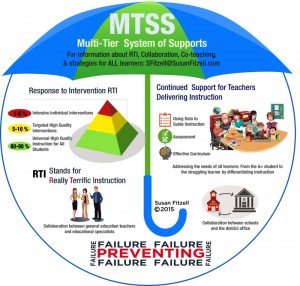MTSS and Really Terrific Instruction at the Secondary Level
 MTSS, Multi Tiered System of Supports, encompasses several approaches, one of which is Response to Intervention (RTI). Here are a few strategies for classroom implementation at the secondary level.
MTSS, Multi Tiered System of Supports, encompasses several approaches, one of which is Response to Intervention (RTI). Here are a few strategies for classroom implementation at the secondary level.
1. Tier One of RTI requires the use of best practice, research-based teaching methods. Research-based strategies implemented in the dif ferentiated classroom reduce the need for interventions.
2. Using frequent progress monitoring, teachers determine where a student is lacking and then seek Tier Two interventions that might be appro priate for that student. Often, Tier Two interventions can be researched-based practices used in Tier One, but with three modifications:
- Specific students receive more intense instruction and application of strategies.
- Students are given more time to practice and implement the strategies.
- The intensity of implementation may increase.
3. Having adequate time to implement interventions is often the greatest challenge faced at the secondary level. When teachers routinely implement small group work, flexible grouping, or center teaching, interventions in Tier Two fall right into place in the general educator’s lesson plan.
4. Rather than forcing teachers to follow a script from a published program, teachers are encouraged to use their professional skills, experience, and an understanding of student needs and data derived from frequent progress monitoring to determine appropriate interventions. The key is using a problem-solving model to hone in on possible interventions.
5. An option for delivering Tier Two instruction that works well for students at the secondary level is a tutored study hall combined with in-class, frequent, immediate interventions made possible by Chunking Lesson Plans®.
6. Tier Three is not as delineated as Tiers One and Two in literature on Response to Intervention. School districts define Tier Three requirements as follows:
- Interventions are more intensive, based on problem-solving models, and implemented through a combination of means including classroom instruction, outside-of-school instruction, or in-school instruction outside of the general classroom.
- A combination of intensive interventions implemented in general edu cation as part of a wrap-around approach to meeting a student’s needs.
- Some school districts, as well as books on the topic of RTI, consider spe cial education to be part of Tier Three.
7. How we assess students to determine their understanding of content is critical to the Response to Intervention process. Keep it simple, frequent, and efficient. Authentic assessments incorporate a variety of measures into the evaluation process and focus on formative assessment. Types of authentic assessment include rubrics, exit cards, curriculum-based measurement, student self-evaluation, and documented observations.
Originally published and copyright© 2012. Excerpted from RTI Strategies for Secondary Teachers by Susan Fitzell, Corwin Press ©2011. www.responsetointernventiononline.com

Bring Susan to your campus!
Featured seminar – Response to Intervention (RTI) Strategies

